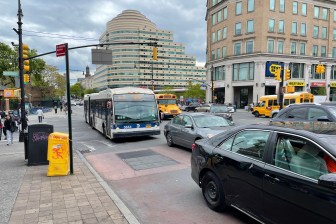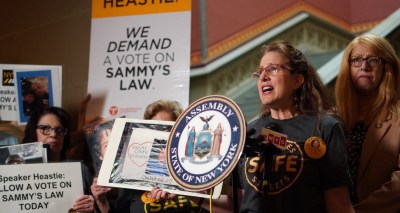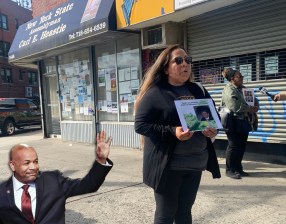An English Plan in New York

The once traffic-filled street between Trafalgar Square and the National Gallery is now a thriving plaza.
 Climate change is a greater threat to London than terrorism, one of the city’s top planners said yesterday.
Climate change is a greater threat to London than terrorism, one of the city’s top planners said yesterday.
Debbie McMullen (right), a one-time New Yorker who heads implementation of the "London Plan," made this matter-of-fact announcement at a Tuesday evening forum, sponsored by the Forum for Urban Design and the Lincoln Institute of Land Policy, and held at the Center for Architecture in the East Village. As New York awaits the unveiling of Mayor Bloomberg’s PlaNYC 2030, McMullen outlined the "spatial development strategy" that London Mayor Ken Livingstone has spearheaded during his seven years in office.
Like PlaNYC, the London Plan, published in 2004, is designed to help mitigate the environmental impacts of a predicted one million new residents in the coming decades. Backed by the power of the Greater London Authority (GLA) — a city-wide governmental structure established in 2000 — the London Plan integrates sustainable development practices with innovative social and economic policies.
As London becomes "younger, more female and less white," said McMullen, the city wants to build 305,000 new housing units over the next 10 years, spread throughout its 32 boroughs. The London Plan calls for 50 percent of those units to be priced for low- and moderate-income citizens. New construction standards cover insulation requirements, building orientation (to make the most of solar power potential), green (or "living") roofs, and renewable on-site energy.
To reduce CO2 from vehicle emissions — in addition to congestion charging, which McMullen said has reduced car trips by 50,000 per day — the London Plan prescribes that scattered "town centres" in the boroughs be linked by public transport routes radiating from the city core, along with other light rail and tram service. The city’s canals are to be relied upon for ferrying more freight and waste, reducing truck traffic on the streets.
The plan is aimed at nothing less than making London a "zero emission city," said McMullen, with CO2 reduction targets of 30 percent by 2025, and 60 percent by 2050.
Rather than imposing mandates to achieve its goals, the GLA works in tandem with the private sector. Though "there is some resistance," as would be expected, grievances are heard by an independent panel and addressed in public. The plan is also monitored through regular progress reports.
"It’s not a plan to sit on the shelf," McMullen said. "The mayor wants it to happen."
It is already paying dividends. Said David Haskell, executive director of the Forum for Urban Design, in introducing McMullen: "The reason London won the (2012) Olympics is that London knows its future."
Joining McMullen for a brief Q&A, Rohit Aggarwala, Director of PlaNYC, downplayed New York City’s loss of the 2012 games, saying it hasn’t slowed new development. One of the few insights Aggarwala offered into PlaNYC came after an audience member asked about planned improvements to the pedestrian environment. While McMullen replied in some detail how pedestrian and cyclist safety was a top priority of the London Plan, Aggarwala cited PlaNYC’s goal of locating a city park within 10 minutes’ walking distance of every New Yorker.
Trafalgar Square photo: Aaron Naparstek, March 3, 2007





